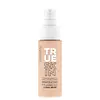What's inside
What's inside
 Key Ingredients
Key Ingredients

 Benefits
Benefits

 Concerns
Concerns

No concerns
 Ingredients Side-by-side
Ingredients Side-by-side

Water
Skin ConditioningIsononyl Isononanoate
EmollientCoconut Alkanes
EmollientGlycerin
HumectantTriethylhexanoin
MaskingMagnesium Sulfate
Polyglyceryl-4 Diisostearate/Polyhydroxystearate/Sebacate
EmulsifyingDiisostearoyl Polyglyceryl-3 Dimer Dilinoleate
EmollientDisteardimonium Hectorite
StabilisingAloe Barbadensis Leaf Juice
Skin ConditioningStearoyl Inulin
EmollientPropylene Carbonate
SolventEthylhexylglycerin
Skin ConditioningHydrogenated Lecithin
EmulsifyingMagnesium Oxide
AbsorbentAluminum Hydroxide
EmollientAlumina
AbrasivePhenoxyethanol
PreservativePotassium Sorbate
PreservativeSodium Benzoate
MaskingCI 77491
Cosmetic ColorantCI 77492
Cosmetic ColorantCI 77499
Cosmetic ColorantCI 77891
Cosmetic ColorantWater, Isononyl Isononanoate, Coconut Alkanes, Glycerin, Triethylhexanoin, Magnesium Sulfate, Polyglyceryl-4 Diisostearate/Polyhydroxystearate/Sebacate, Diisostearoyl Polyglyceryl-3 Dimer Dilinoleate, Disteardimonium Hectorite, Aloe Barbadensis Leaf Juice, Stearoyl Inulin, Propylene Carbonate, Ethylhexylglycerin, Hydrogenated Lecithin, Magnesium Oxide, Aluminum Hydroxide, Alumina, Phenoxyethanol, Potassium Sorbate, Sodium Benzoate, CI 77491, CI 77492, CI 77499, CI 77891
Water
Skin ConditioningIsododecane
EmollientTalc
AbrasiveCoco-Caprylate
EmollientHydrogenated Tetradecenyl/Methylpentadecene
SolventTrimethylsiloxysilicate
EmollientCetyl PEG/PPG-10/1 Dimethicone
EmulsifyingPropanediol
SolventDimethicone
EmollientSodium Chloride
MaskingPEG-10 Dimethicone
Skin ConditioningSodium Hyaluronate
HumectantCitrullus Lanatus Seed Oil
EmollientTocopherol
AntioxidantDisteardimonium Hectorite
StabilisingCaprylyl Glycol
EmollientTriethoxycaprylylsilane
Dimethiconol Stearate
EmollientHexylene Glycol
EmulsifyingAluminum Hydroxide
EmollientPotassium Sorbate
PreservativeSodium Dehydroacetate
PreservativePhenoxyethanol
PreservativeParfum
MaskingCI 77491
Cosmetic ColorantCI 77492
Cosmetic ColorantCI 77499
Cosmetic ColorantCI 77891
Cosmetic ColorantWater, Isododecane, Talc, Coco-Caprylate, Hydrogenated Tetradecenyl/Methylpentadecene, Trimethylsiloxysilicate, Cetyl PEG/PPG-10/1 Dimethicone, Propanediol, Dimethicone, Sodium Chloride, PEG-10 Dimethicone, Sodium Hyaluronate, Citrullus Lanatus Seed Oil, Tocopherol, Disteardimonium Hectorite, Caprylyl Glycol, Triethoxycaprylylsilane, Dimethiconol Stearate, Hexylene Glycol, Aluminum Hydroxide, Potassium Sorbate, Sodium Dehydroacetate, Phenoxyethanol, Parfum, CI 77491, CI 77492, CI 77499, CI 77891
 Reviews
Reviews

Ingredients Explained
These ingredients are found in both products.
Ingredients higher up in an ingredient list are typically present in a larger amount.
Aluminum Hydroxide is a form of aluminum. It can be naturally found in nature as the mineral gibbsite. In cosmetics, Aluminum Hydroxide is used as a colorant, pH adjuster, and absorbent.
As a colorant, Aluminum Hydroxide may add opacity, or reduce the transparency. Aluminum hydroxide is contains both basic and acidic properties.
According to manufacturers, this ingredient is an emollient and humectant. This means it helps hydrate the skin.
In medicine, this ingredient is used to help relieve heartburn and help heal ulcers.
There is currently no credible scientific evidence linking aluminum hydroxide in cosmetics to increased cancer risk.
Major health organizations allow the use of aluminum hydroxide in personal care products and have not flagged it as a carcinogenic risk at typical usage levels.
Learn more about Aluminum HydroxideCi 77491 is also hydrated iron III oxide. It's sole purpose is to give a red/pink hue to products.
Iron III oxides are classified as inorganic chemicals for coloring.
Synthetically created Ci 77491 is considered safer than those naturally found. This is because the synthetically created version may contain less impurities. Iron oxides are generally non-toxic and non-allergenic.
Learn more about CI 77491Ci 77492 is also hydrated iron III oxide. It's sole purpose is to give a yellow hue to products.
Iron III oxides are classified as inorganic chemicals for coloring.
Synthetically created Ci 77492 is considered safer than those naturally found. This is because the synthetically created version may contain less impurities. Iron oxides are generally non-toxic and non-allergenic.
Learn more about CI 77492Ci 77499 is also hydrated iron III oxide. It is created from mixing red and black iron oxides. This helps give shades of darkness to a product.
Iron III oxides are classified as inorganic chemicals for coloring.
Ci 77891 is a white pigment from Titanium dioxide. It is naturally found in minerals such as rutile and ilmenite.
It's main function is to add a white color to cosmetics. It can also be mixed with other colors to create different shades.
Ci 77891 is commonly found in sunscreens due to its ability to block UV rays.
Learn more about CI 77891Disteardimonium Hectorite comes from the clay mineral named hectorite. It is used to add thickness to a product.
It can also help stabilize a product by helping to disperse other ingredients.
Hectorite is a rare, white clay mineral.
Learn more about Disteardimonium HectoritePhenoxyethanol is a preservative that has germicide, antimicrobial, and aromatic properties. Studies show that phenoxyethanol can prevent microbial growth. By itself, it has a scent that is similar to that of a rose.
It's often used in formulations along with Caprylyl Glycol to preserve the shelf life of products.
Potassium Sorbate is a preservative used to prevent yeast and mold in products. It is commonly found in both cosmetic and food products.
This ingredient comes from potassium salt derived from sorbic acid. Sorbic acid is a natural antibiotic and effective against fungus.
Both potassium sorbate and sorbic acid can be found in baked goods, cheeses, dried meats, dried fruit, ice cream, pickles, wine, yogurt, and more.
You'll often find this ingredient used with other preservatives.
Learn more about Potassium SorbateWater. It's the most common cosmetic ingredient of all. You'll usually see it at the top of ingredient lists, meaning that it makes up the largest part of the product.
So why is it so popular? Water most often acts as a solvent - this means that it helps dissolve other ingredients into the formulation.
You'll also recognize water as that liquid we all need to stay alive. If you see this, drink a glass of water. Stay hydrated!
Learn more about Water